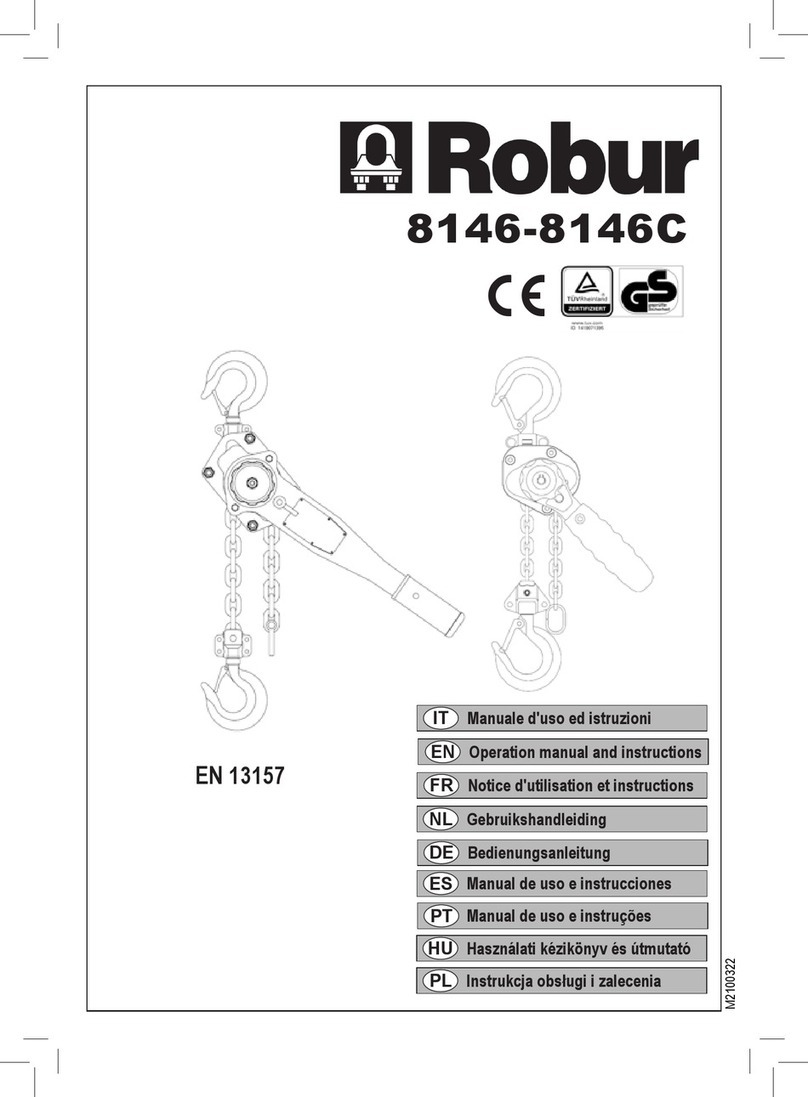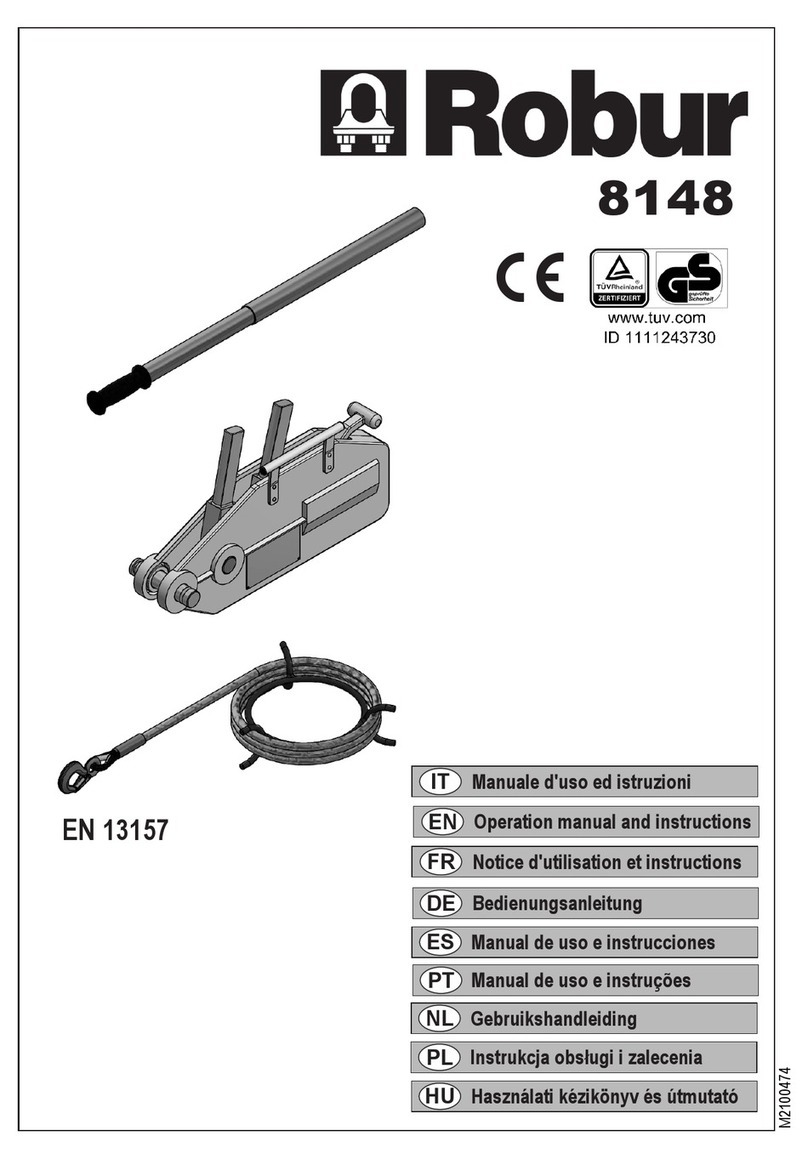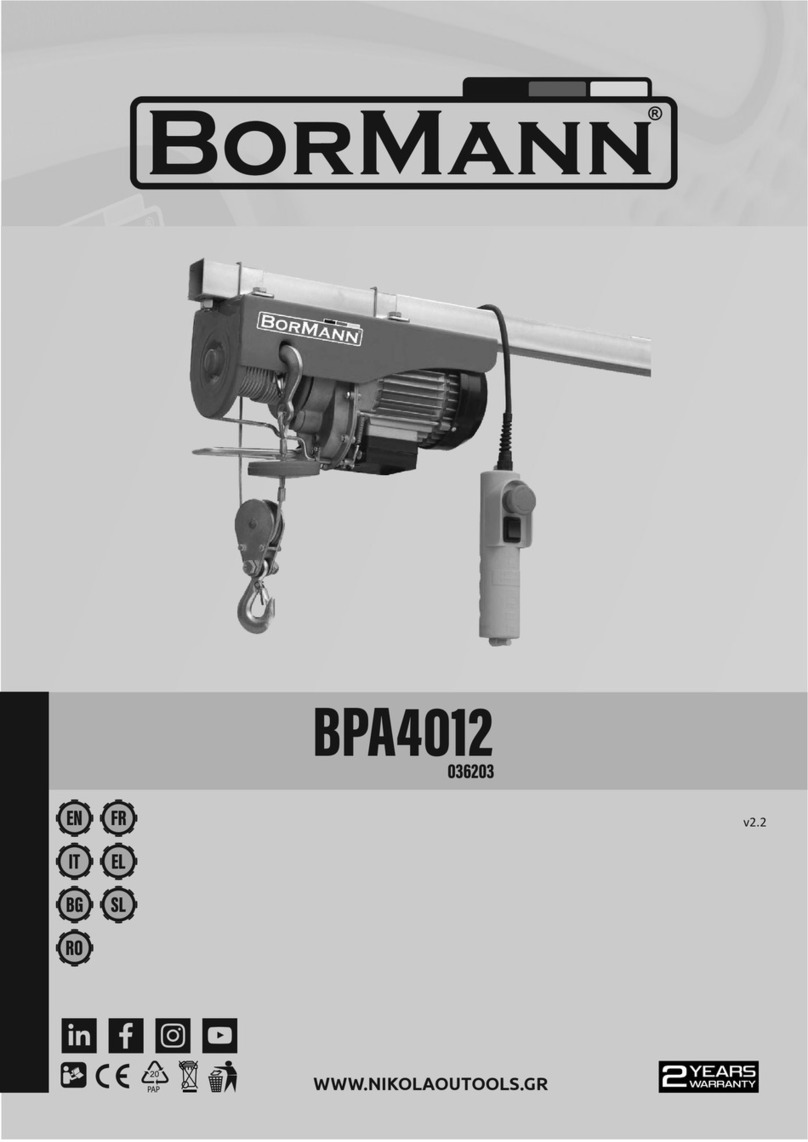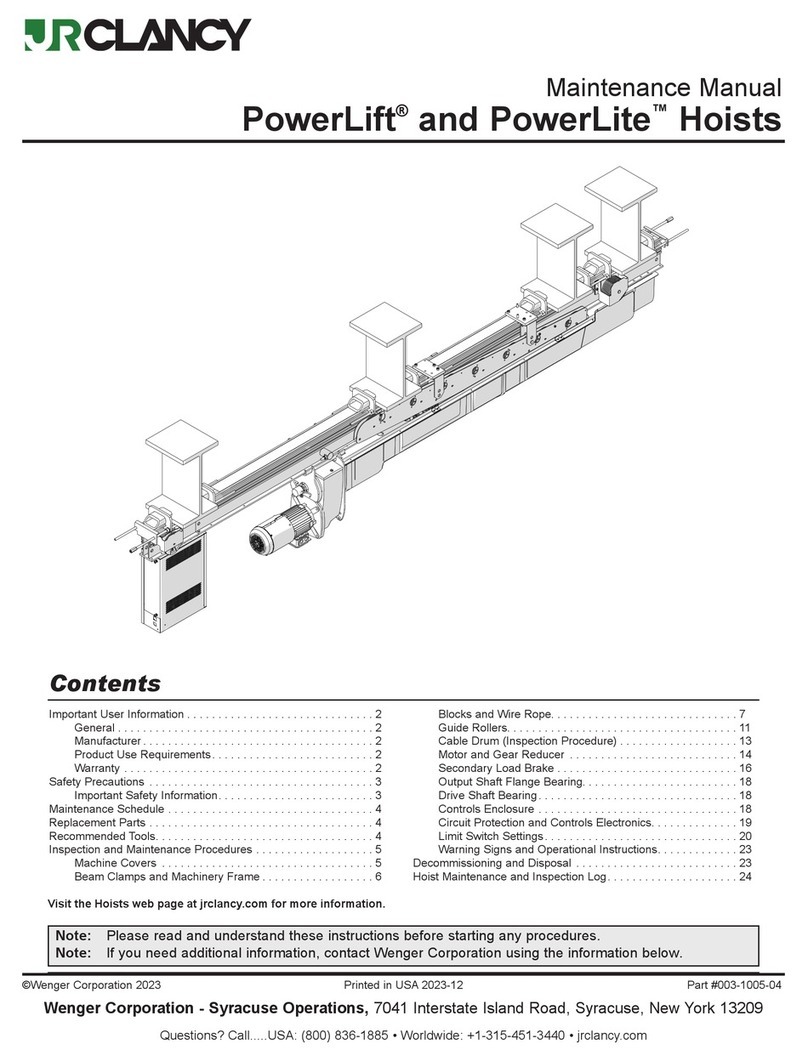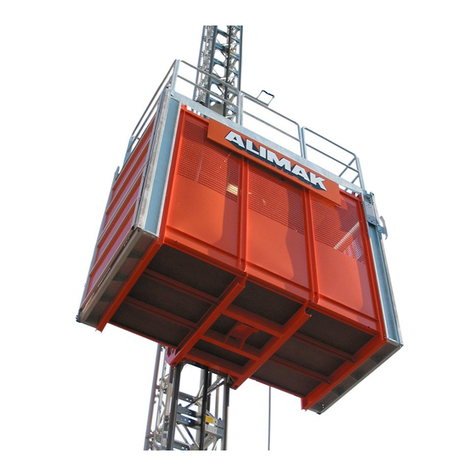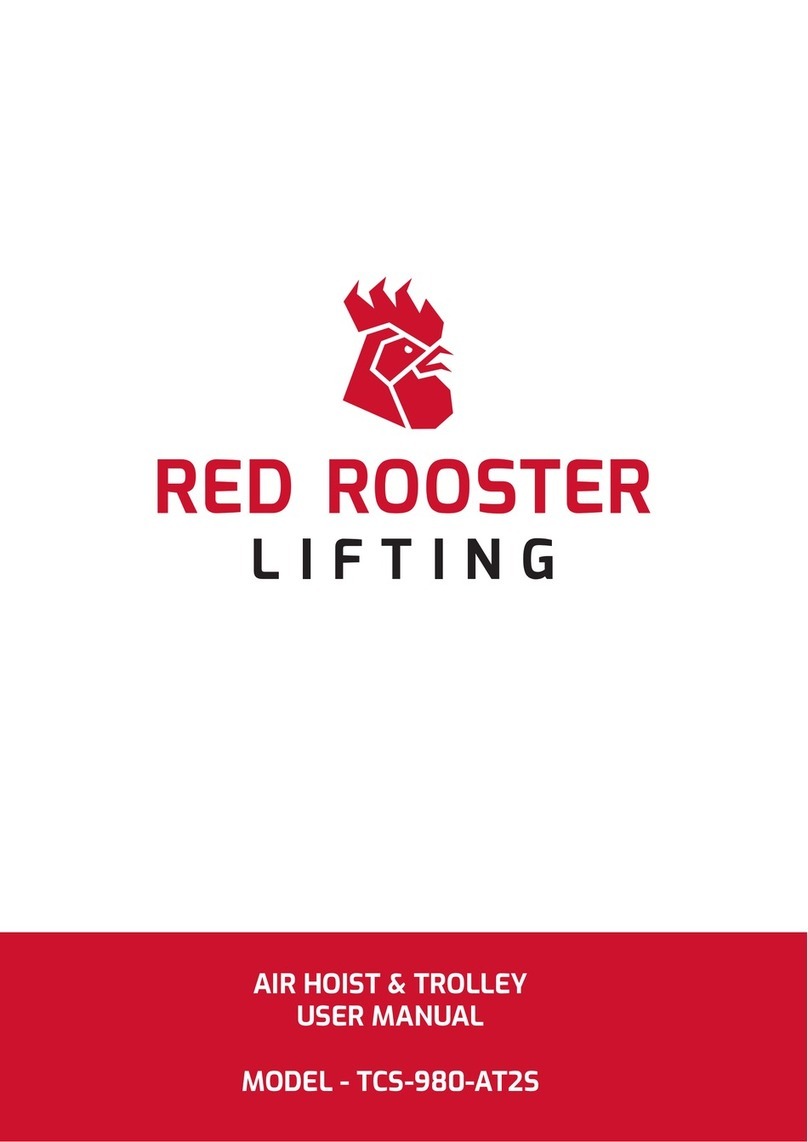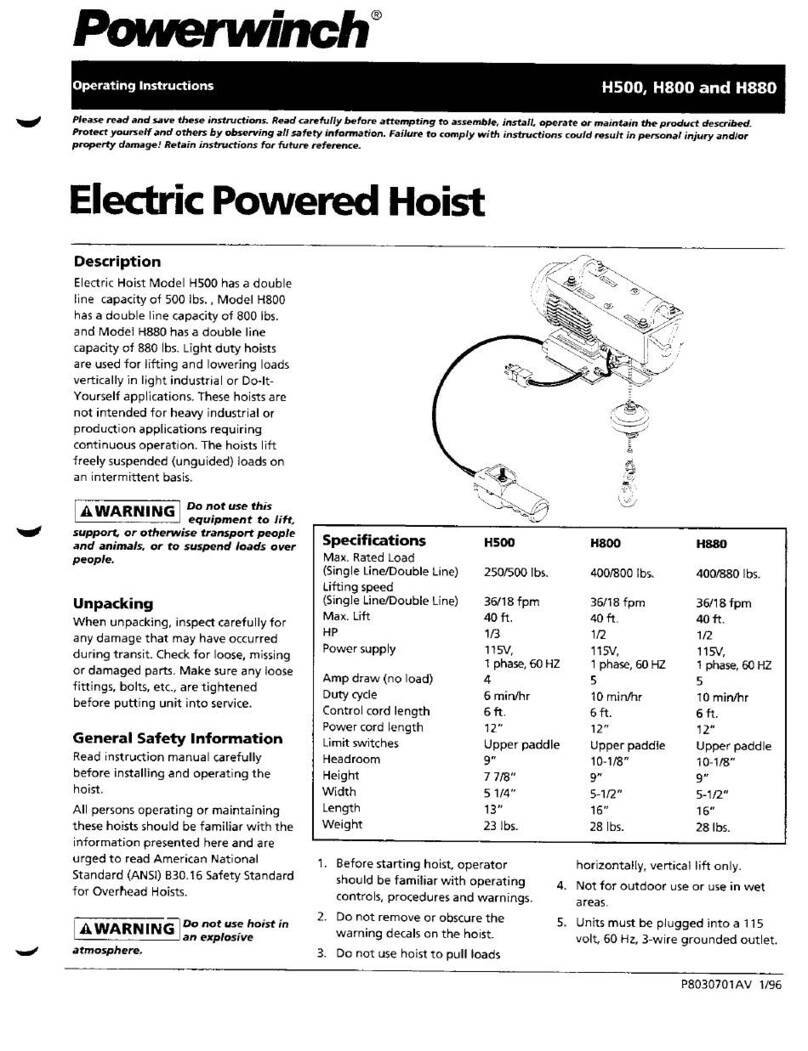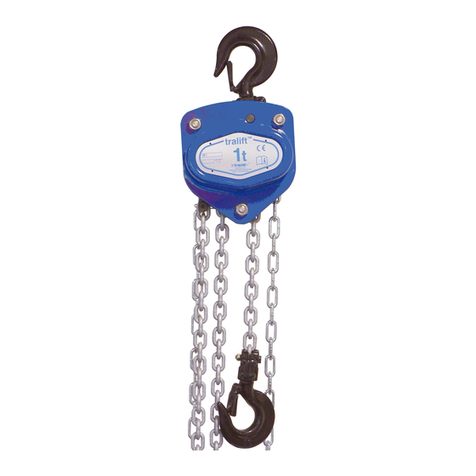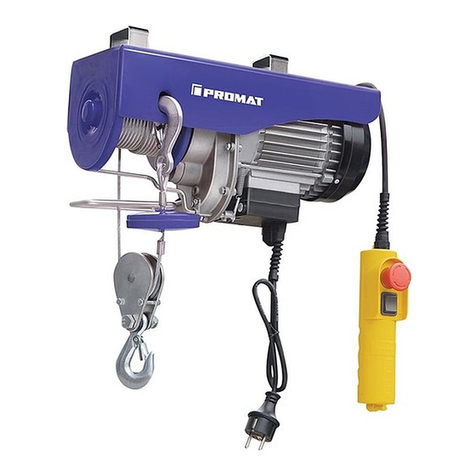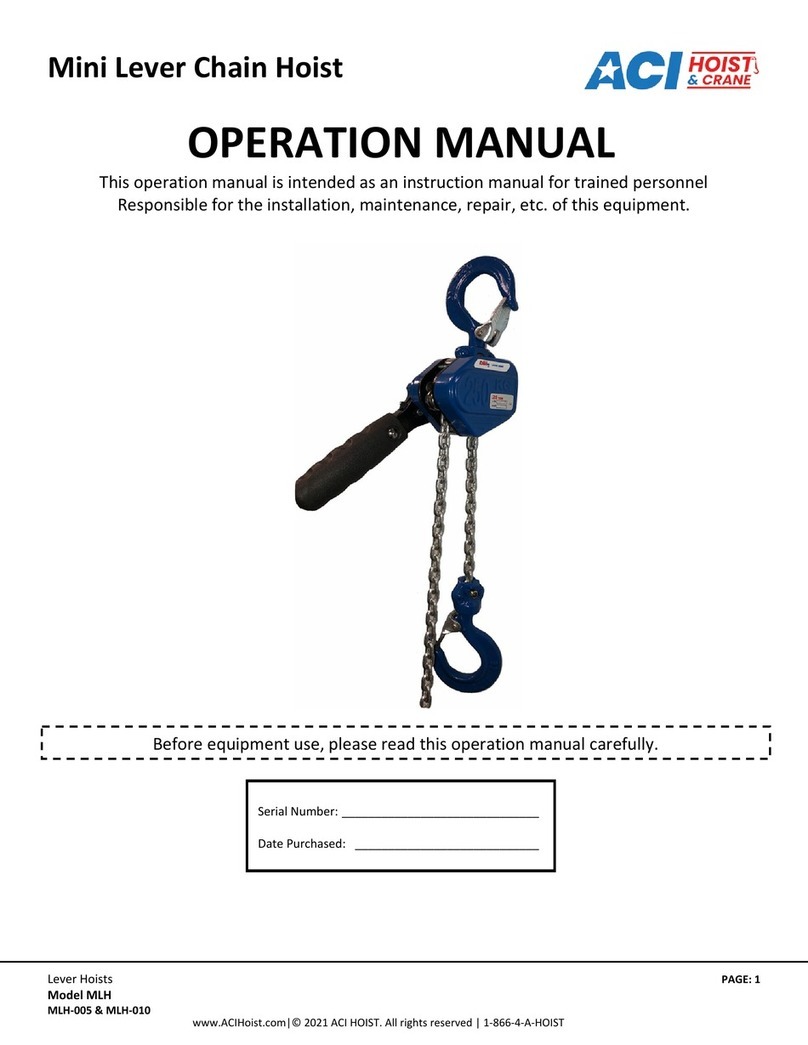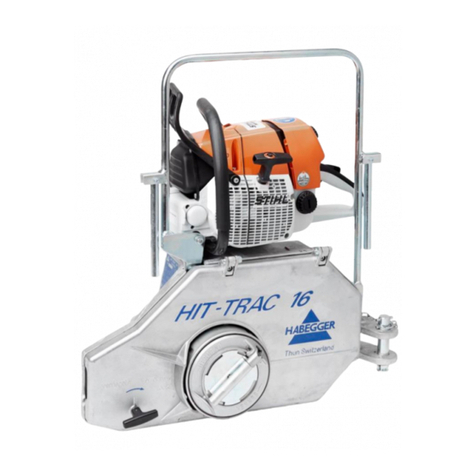Robur 8143 Supplement

8143
Manuale d'uso ed istruzioni
IT
Operation manual and instructions
EN
Notice d'utilisation et instructions
FR
Gebruikshandleiding
NL
Bedienungsanleitung
DE
Manual de uso e instrucciones
ES
Manual de uso e instruções
PT
Használati kézikönyv és útmutató
HU
Instrukcja obsługi i zalecenia
PL
EN 13157
Prima
M2100321

2
MANUALE D’USO ED ISTRUZIONI IT
MANUALE D’USO ED ISTRUZIONI PER PARANCHI A CATENA 8143
BETA UTENSILI S.P.A. – Divisione Robur
Zona Industriale - C.da San Nicola
67039, Sulmona (L’Aquila)
ITALIA
Documentazione redatta originariamente in lingua ITALIANA.
Conservare accuratamente le istruzioni di sicurezza e consegnarle al personale utilizzatore.
In caso di smarrimento o deterioramento, il manuale può essere facilmente recuperato sul sito web del costruttore:
www.beta-tools.com
IMPORTANTE LEGGERE COMPLETAMENTE IL PRESENTE MANUALE PRIMA DI
UTILZZARE IL PARANCO. IN CASO DI MANCATO RISPETTO DELLE NORME DI
SICUREZZA E DELLE ISTRUZIONI OPERATIVE, POSSONO VERIFICARSI SERI
INFORTUNI.
ATTENZIONE
AVVERTENZE GENERALI
- Prima di ogni utilizzo del paranco, assicurarsi che:
•Il paranco sia visibilmente in buone condizioni;
•La catena di carico e i ganci siano in buone condizioni
(p.e. senza segni di usura, piega, corrosione);
• Il ne corsa inferiore sia presente;
• Il paranco soddis tutte le regolamentazioni sul
lavoro riguardanti installazione, veriche periodiche,
manutenzione ed uso;
- Il paranco deve essere ispezionato e manutenuto con
regolarità da una persona competente per assicurarne il
suo uso in sicurezza. Esso deve essere controllato contro
ogni segno di corrosione o usura prematura, a seconda
delle condizioni di lavoro.
- Assicurarsi che tutte le persone che debbano utilizzare il
paranco siamo propriamente formate, conoscano tutte le
funzionalità e le operazioni da eseguire con l’attrezzatura
e conoscano tutte le regolamentazioni e i requisiti di
sicurezza.
- Il paranco deve essere usato solo nel pieno rispetto di
tutte le regolamentazioni di sicurezza e le norme applicabili
nel luogo di utilizzo, riguardanti installazione, uso,
manutenzione e ispezione dei dispositivi di sollevamento.
- Il paranco deve essere posto sotto la responsabilità
di una persona che conosca perfettamente tutte le
regolamentazioni applicabili nel luogo di utilizzo, e che
abbia l’autorità di farle rispettare.
- L’installazione e la messa in servizio del paranco deve
essere fatta in condizioni di sicurezza per l’installatore, in
accordo alle regolamentazioni applicabili.
- Beta Utensili S.p.a. declina ogni responsabilità per l’utilizzo
del paranco in qualsiasi congurazione d’uso e montaggio
diversa da quelle descritte in questo manuale d’uso.
- Il paranco deve essere ssato ed ancorato ad una struttura
che abbia resistenza meccanica sufciente a sopportare il
carico massimo di esercizio (WLL).
- Usando il paranco, l’utilizzatore deve assicurare che la
catena di carico sia costantemente in tensione per mezzo
del carico, e che esso non sia provvisoriamente trattenuto
da un ostacolo durante la discesa. Questo può causare la
rottura della catena quando il carico viene rilasciato.
- Usando il paranco, l’utilizzatore deve assicurare che non ci
saranno ostacoli che possano grafare la catena.
- Se sono utilizzati più paranchi per il sollevamento di un
carico, è necessario uno schema di sollevamento, denito
e approvato da un tecnico qualicato.
- Beta Utensili S.p.a. declina ogni responsabilità per le
conseguenze derivanti dall’uso del paranco in combinazione
con altri dispositivi di sollevamento di altri produttori.
- L’operatore deve osservare continuamente il carico
per prevenire qualsiasi rischio di trattenuta durante le
operazioni di sollevamento (salita o discesa L’operatore
deve osservare continuamente il carico per prevenire
qualsiasi rischio di trattenuta durante le operazioni di
sollevamento (salita o discesa).
- Il paranco, inclusi la catena di carico e i ganci, non deve
essere disassemblato o riparato da personale non
autorizzato. Qualsiasi disassemblaggio o riparazione non
autorizzata solleva Beta Utensili da ogni responsabilità
risultante.
- Il paranco non deve essere modicato. Beta Utensili S.p.a.
declina ogni responsabilità per le conseguenze di qualsiasi
modica fatta sul paranco, o per la rimozione di parti che
formano l’attrezzatura.
- Beta Utensili S.p.a. garantisce l’operatività del paranco
fornito solo se esso è equipaggiato con parti originali
e componenti, inclusi catena e ganci, in accordo alle
speciche indicate in questo manuale d’uso. La sostituzione
di parti originali e componenti, inclusi catena e ganci, con
quelli di un altro produttore, solleva Beta Utensili S.p.a. da
ogni responsabilità per qualsiasi conseguenza risultante.
- La tabella delle manutenzioni, alla ne di questo manuale
d’uso, deve essere mantenuta aggiornata come il manuale
delle manutenzioni da una persona competente.
DESCRIZIONE DEL PARANCO
Il paranco manuale a catena Robur è un paranco portatile
azionato a mano. E’ progettato per sollevare un carico
sospeso ad una catena di carico tramite l’azionamento di
una catena a mano.
E’ utilizzato generalmente collegato ad un punto di
ancoraggio sso.
E’ costruito con materiali di alta qualità ed ha un design
compatto, leggero e maneggevole. E’ portatile e facile da
installare. E’ dotato di un Sistema a cricchetto a doppio

3
MANUALE D’USO ED ISTRUZIONI IT
saltarello per garantire sollevamenti in condizioni di totale sicurezza per gli operatori. La catena di carico è assicurata ad un ne
corsa inferiore, ssato al corpo del paranco.
SPECIFICHE TECNICHE
Fig. 1
WLL
(t)
Altezza di
sollevamento
standard (m)
Distanza
minima
tra i ganci
H (mm)
Sforzo
operativo alla
capacità no-
minale (daN)
Numero
di tiri di
catena
Dimensioni (mm) Dimensioni
della catena
(mm)
Peso
netto
(kg) Codice
A B D
0,5 3,0 285 27 1 126 145 28 5x15 8,5 081430005
1,0 3,0 315 44 1 151 159 32 6.3x19 12 081430010
1,5 3,0 340 44 1 151 178 36 8x24 15 081430015
2,0 3,0 380 44 1 183 205 36 8x24 19,5 081430020
3,0 3,0 475 45 2 151 208 46 8x24 21,5 081430030
5,0 3,0 600 47 2 183 264 46 10x30 38 081430050
CALZATURE DI SICUREZZA
GUANTI DI PROTEZIONE PER AGENTI FISICI
ELMETTO
DISPOSTIVI DI PROTEZIONE INDIVIDUALI CHE DEVONO ESSERE INDOSSATI

4
MANUALE D’USO ED ISTRUZIONI IT
INSTALLAZIONE
Prima di iniziare l’installazione attenersi alle avvertenze
generali. Inoltre:
- Controllare il WLL del paranco per vericare che la capacità
sia idonea.
- Controllare che la catena di carico non sia aggrovigliata e
che sia correttamente installata.
Solo dopo il completamento dei controlli preliminari è
possibile connettere il paranco al punto di ancoraggio ed
eseguire i seguenti controlli:
- Controllare che il paranco sia correttamente sospeso per
mezzo del suo gancio di sospensione e che la sicura sia
completamente chiusa.
- Controllare che la catena di carico non abbia subito alcuna
torsione in fase di installazione.
- Controllare il corretto funzionamento delle funzioni di
sollevamento e abbassamento senza applicare carichi.
- Se il paranco è installato su dispositivi di ancoraggio
mobili (p.e. carrelli di sospensione), controllare il corretto
funzionamento di questi dispositivi.
Dopo aver completato con successo questi controlli, mettere
il carico in posizione ed assicurarsi che:
- Il dispositivo di connessione del carico poggi
completamente sul gancio di carico e che sia possibile
chiudere completamente la sicura.
- Il carico applicato al paranco sia libero di allinearsi con il
suo punto di ancoraggio.
OPERAZIONI
Per regolare la lunghezza della catena di sollevamento è
necessario procedere come segue:
- Tirare la catena a mano nella direzione di sollevamento (per
accorciare la catena) o nella direzione di abbassamento
(per allungare la catena). Le direzioni di sollevamento /
abbassamento (“U” / “D”) sono stampate direttamente sul
corpo del paranco (g.2).
- Assicurare il gancio di carico al carico da sollevare.
- Applicare una leggera tensione alla catena di carico tirando
la catena a mano nella direzione di sollevamento.
Manovrare il paranco:
- Tirare la catena a mano nella direzione di sollevamento per
sollevare il carico;
- Tirare la catena a mano nella direzione di abbassamento
per abbassare il carico.
Non manovrare la catena troppo rapidamente al ne
di evitare sobbalzi del carico durante le operazioni di
sollevamento o di abbassamento. La catena a mano
dovrebbe essere tirata con azionamenti regolari per
evitare oscillazioni del carico.
Importante:
Mettendo il paranco fuori servizio, assicurarsi che non
ci siano carichi applicati e che la catena sia rilasciata
abbastanza per essere rimossa dal carico.
Fig. 2
DIREZIONE
DI ABBASSAMENTO
CATENA DI CARICO
CATENA A MANO
DIREZIONE
DI SOLLEVAMENTO
IMMAGAZZINAMENTO
Il paranco dovrebbe essere immagazzinato appeso per
evitare aggrovigliamenti della catena di carico, in un
ambiente asciutto e isolato dall’acqua. Pulire il paranco
e lubricare la catena usando olio lubricante prima
dell’immagazzinamento.
CATENA DI CARICO
Per accertarsi delle buone condizioni, quando il paranco viene
usato, la catena di carico deve essere ispezionata giornalmente
da una persona competente. La catena deve essere pulita e
lubricata a intervalli regolari usando olio lubricante.
Non esporre la catena di carico a temperature
eccessive, agenti chimici, materiale abrasivi e archi
di saldatura.
MANUTENZIONE
Il paranco deve essere ispezionato e testato periodicamente
con un carico da una persona competente, almeno una volta
all’anno e, in ogni caso, in accordo alle regolamentazioni di
sicurezza in uso nel Paese di utilizzo.
Periodicamente, specialmente dopo usi pesanti o intensivi, è
necessario lubricare i componenti meccanici.
Il freno deve rimanere pulito e asciutto. Non bisogna
mai far entrare in contatto i dischi dei freni con il
lubricante.
Le condizioni dei ganci devono essere controllate
regolarmente. La massima deformazione accettabile
sull’apertura (“D”, g. 1) del gancio è 3 mm.

5
ISTRUZIONI PER L’USO I
MANUALE D’USO ED ISTRUZIONI IT
GARANZIA
Questa attrezzatura è prodotta e testata secondo le norme
attualmente vigenti nell’UE; è coperta da una garanzia di
12 mesi per uso professionale e di 24 mesi per uso non
professionale.
Vengono riparati guasti dovuti a difetti di materiale o di
produzione mediante ripristino o sostituzione dei pezzi
difettosi a nostra discrezione.
L’effettuazione di uno o più interventi nel periodo di garanzia
non modica la data di scadenza della stessa.
Non sono soggetti a garanzia difetti dovuti ad usura, uso
errato od improprio, rotture causate da colpi e/o cadute.
Inoltre la garanzia decade quando vengono apportate
modiche, quando l’attrezzatura viene manomessa o quando
viene inviata all’assistenza smontata.
Sono espressamente esclusi danni causati a persone e/o
cose di qualsiasi genere e/o natura, diretti e/o indiretti.
Contatti assistenza clienti
Beta Utensili S.p.a. – Divisione Robur
Zona Industriale - C.da San Nicola
67039, Sulmona (L’Aquila) - ITALIA
Tel. +39 0864.2504.1 – Fax +39 0864.253132
info@roburitaly.com
PROCEDURA DI EMERGENZA IN CASO DI INCIDENTE
In caso di malfunzionamento del paranco:
- Fermare immediatamente tutte le attività
- Predisporre un perimetro di sicurezza.
- Chiamare il personale qualicato per rimuovere il carico.
MARCATURA
Tutte le informazioni del paranco sono contenute su una
targa dati ssata al paranco stesso (g. 3).
Come leggere le marcature:
1) Logo del fabbricante (Robur)
2) Marchio CE
3) Logo TUV-GS
4) Modello numero
5) Norma di riferimento
6) Dimensione catena e grado
7) Numero di serie
8) Mese-anno di costruzione
9) Carico limite di lavoro
10) Beta Utensili S.p.A
11) Nome articolo
Il numero di serie è composto da due parti:
a) Numero di lotto
b) Numero progressivo
HSZXXXXX-XXX
1
9
7
11 23
4
5
6
10
8
CONTROINDICAZIONI D’USO
E’ vietato:
- Usare il paranco se non sono rispettate tutte le indicazioni
presenti tra le avvertenze generali.
- Usare il paranco se la targa dati e/o le marcature sono
mancanti e/o illeggibili.
- Usare il paranco se esso e i suoi componenti non sono in
buone condizioni.
- Usare il paranco se catena e ganci non sono correttamente
installati.
- Usare il paranco se i dispositivi di sicurezza non sono
correttamente operativi o sono danneggiati.
- Fissare il paranco con qualsiasi dispositivo diverso dal suo
gancio di sospensione.
- Bloccare il gancio di sospensione.
- Usare il paranco per scopi o congurazioni diversi o diverse
da quelli descritti in questo manuale d’uso.
- Motorizzare il paranco o azionarlo con modalità diversa da
quella indicata.
- Pulire il paranco usando dispositivi di pulizia ad alta
pressione e/o usando prodotti chimici aggressivi (p.e. acidi,
prodotti clorati).
- Utilizzare il paranco superando il valore del WLL.
- Usare il paranco in ambienti con temperature al di fuori del
campo -10°C ÷ 50°C.
- Usare il paranco per sollevare un carico in ambienti dove
la velocità del vento è tale da comprometterne la stabilità.
- Usare il paranco per sollevare o muovere persone.
- Usare il paranco in ambienti esplosivi o corrosivi.
- Cercare di sollevare un carico vincolato.
- Usare il paranco o la catena di carico come una braca.
- Applicare il carico alla catena a mano o usare la catena a
mano come una braca.
- Usare il paranco come massa elettrica o conduttore
elettrico.
- Applicare il carico sulla punta del gancio.
- Forzare la catena a mano per sollevare o abbassare un
carico se il gancio di sollevamento è contro il corpo del
paranco oppure se la catena di carico si trova contro il ne
corsa inferiore.
- Tirare lateralmente un carico da sollevare.
- Far oscillare il carico sotto il paranco.
- Sostare o muoversi sotto il carico.
- Intervenire sul paranco senza prima aver rimosso il carico.
DICHIARAZIONE DI CONFORMITÀ
Dichiariamo sotto la nostra responsabilità che il prodotto
descritto è conforme a tutte le disposizioni pertinenti della
Direttiva Macchine 2006/42/CE e relative modiche, nonché
alla seguente normativa:
• EN 13157
Il Fascicolo Tecnico è disponibile presso:
BETA UTENSILI S.P.A. – Divisione Robur
Zona Industriale - C.da San Nicola
67039 Sulmona (L’Aquila)
ITALIA
a b
Fig. 3

6
ISTRUZIONI PER L’USO I
OPERATION MANUAL AND INSTRUCTIONS EN
USER MANUAL AND INSTRUCTIONS FOR HAND CHAIN BLOCK 8143
:
BETA UTENSILI S.P.A. – Divisione Robur
Zona Industriale - C.da San Nicola
67039, Sulmona (L’Aquila)
ITALY
Original documentation drawn up in ITALIAN.
Store the safety instruction with care and hand them to the users.
Should it be lost or damaged, the manual can easily be retrieved on the constructor's web site: www.beta-tools.com
in combination with other lifting devices of another
manufacturer.
- The operator must continuously observe the load to
prevent any risk of snagging during lifting operations (up
or down).
- The hoist, including lifting chain and hooks, must not
be disassembled or repaired by unauthorized people.
Any unauthorized disassembly or repair of the hoist will
release Beta Utensili of any resulting responsibility.
- The hoist must not be modied. Beta Utensili S.p.a.
declines any responsibility for the consequence of any
changes made to the hoist or removal of parts forming the
equipment.
- Beta Utensili S.p.a. will only guarantee operation of the hoist
provided if it is equipped with genuine parts and components,
including chain and hooks, according to the specications
indicated in this user manual. The replacement of genuine
parts and components, including lifting chain and hooks with
the ones of another manufacturer, will release Beta Utensili
S.p.a. of its responsibility for any resulting consequences.
- The maintenance table at the end of this user manual
must be maintained updated like a servicing manual by
competente people.
- When not being used, the hoist must be stored in a location
not accessible to people not authorized to its use.
- If the hoist has to be denitively removed from service,
all environment protection regulations applicable in the
Country of use must be observed.
- The operator shall ensure that he has a stable support
before operating the hoist. Otherwise, he must be properly
secured.
- Any activity that could divert the attention of the operator
during the operation must not be engaged.
- Before use the hoist, the operator must ensure that he
has the complete view of the operation, and that the
environment is correctly lit, to avoid injuries to people or
damages to equipments.
- The operator should not leave a loaded hoist unattended
for long periods; if this condition cannot be avoided, the
operator must ensure that it doesn’t create hazard to
people or equipments.
IT IS IMPORTANT TO READ THIS MANUAL THOROUGHLY BEFORE USING
THE HOIST. FAILURE TO COMPLY WITH THE SAFETY STANDARDS AND
OPERATING INSTRUCTIONS MAY RESULT IN SERIOUS INJURY.
CAUTION
GENERAL WARNINGS
- Each time before using the hoist, make sure that:
•The hoist is in visibly good conditions;
•The load chain and hooks are in good conditions (i.e. without
signs of wear, bending and corrosion);
•The low limit stop is in place;
•The hoist comply with all safety work regulation concerning
installation, periodic verication, maintenance and use;
•The hoist must be inspected and serviced regularly by
competent people to ensure its safe use. It must be
checked for any signs of corrosion or premature wear,
depending on the working conditions.
- Make sure that all people that have to use the hoist
are properly trained, know all the functionality and the
operations to be done with the equipment and know all
safety regulations and requirements.
- The hoist must be used only in full compliance of all safety
regulation and standards applicable in the place of use,
concerning installation, use, maintenance and inspection
of lifting devices.
- The hoist must be placed under the responsibility of a person
that perfectly know all regulation applicable in the place of
use, and having the authority to enforce the application of
these regulations.
- The installation and put in service of the hoist must be
done in safety conditions for the installer according to the
applicable regulation.
- Beta Utensili S.p.a. declines any responsibility for the use
of the hoist in any using and tting congurations other than
the ones described in this user manual.
- The hoist must be fastened to an anchoring structure having
a necessary mechanical strength to support the working
load limit (WLL).
- Using the lever hoist, the user must ensure that the load
chain remain constantly tensioned by the load and the load
has not been temporarily snagged by an obstacle when
coming down. This can cause the breakage of the chain
when the load is released.
- Using the lever hoist, the user must ensure that there won’t
obstacle that can scratch the load chain.
- If several hoist are to be used to lift the load, is necessary
a lifting scheme dened and approved by a qualied
technician.
- Beta Utensili S.p.a. declines any responsibility for
the consequences related from the use of the hoist

7
DESCRIPTION OF THE HOIST
Robur hand chain block is a portable manual actuated hoist. It is designed for lifting a load suspended on a load chain by manually
actuating an hand chain.
It is normally used on a xed anchoring point.
It is manufactured with high quality materials and has a compact, light and manageable design. It is portable and easy to install.
It has a double pawl ratchet system to guarantee the reliability of lifting in total security for the operators.
The lifting chain is secured to a low limit stop itself secured to the hoist.
ISTRUZIONI PER L’USO I
OPERATION MANUAL AND INSTRUCTIONS EN
Fig. 1
WLL
(t)
Standard
lifting height
(m)
Minimum
distance
between
hooks H
(mm)
Operating
effort at nomi-
nal capacity
(daN)
Num-
ber of
strands
Dimension (mm) Chain
dimension
(mm)
Net
weight
(kg) Code
A B D
0,5 3,0 285 27 1 126 145 28 5x15 8,5 081430005
1,0 3,0 315 44 1 151 159 32 6.3x19 12 081430010
1,5 3,0 340 44 1 151 178 36 8x24 15 081430015
2,0 3,0 380 44 1 183 205 36 8x24 19,5 081430020
3,0 3,0 475 45 2 151 208 46 8x24 21,5 081430030
5,0 3,0 600 47 2 183 264 46 10x30 38 081430050
SAFETY SHOES
SAFETY GLOVES AGAINST PHISICAL AGENTS
HELMET
INDIVIDUAL PROTECTION DEVICES TO BE WEAR USING THE HOIST
TECHNICAL SPECIFICATIONS

8
OPERATION MANUAL AND INSTRUCTIONS EN
INSTALLATION
Before to start the installation follow the general warning.
Moreover:
- Check the WLL of the hoist to verify if the capacity is correct.
- Check that the load chain is not twisted and it is correctly
installed.
Only after completion of preliminary checks it will be possible
to connect the hoist at the anchoring point and perform the
following checks:
- Check that the hoist is correctly suspended by its
suspension hook and that the latch is completely closed.
- Check that the loading chain has not subject to any torsion
when setting up.
- Check the correct functionality of up and down functions
without apply the load.
- If the hoist is installed on mobile anchoring devices (i.e.
suspension trolley), check the correct functionality of these
devices.
After successfully completing these checks, place the load in
position and ensure:
- The connecting device of the load sits fully in the loading
hook and that is possible to close completely the latch.
- The load on the hoist is free to align itself with the hoist’s
anchoring point.
OPERATION
For the adjustment of the load chain length, is necessary to
proceed as follow:
- Pull the hand chain in the lifting direction (to shorten
the chain) or in the lowering direction (to lengthen the
chain). Lifting / lowering directions (“U” / "D"), are directly
embossed on the hoist body (g.2).
- Secure the lifting hook to the load to be lifted.
- Slightly tension the load chain by pulling the hand chain in
lifting direction.
Operating the hoist:
- Pull the hand chain to lifting direction to lift the load.
- Pull the hand chain to lowering direction to lower the load.
Do not operate the chain too quickly in order to avoid
load jolts during lifting or lowering operations.
The hand chain should be pulled by a regular and
smooth actions to avoid swinging of the load.
Important:
Taking the hoist out of service, ensure that there is not
load applied and that the load chain is loose enough to
enable the bottom hook to be removed from the load.
Fig. 2
LOWERING
DIRECTION
LOAD CHAIN
HAND CHAIN
LIFTING DIRECTION
STORAGE
The hoist should be stored hanging to avoid tangling of the
load chain, in a dry and water-proof area. Clean the hoist and
lubricate the chain using machine oil before to store.
LOAD CHAIN
To be aware of the good condition, the load chain must
be inspected daily by a competent people when the hoist
is being used. The chain must be clean and lubricated at
regular intervals using machine oil.
Do not expose the chain to excessive temperatures,
chemical agents, abrasive materials and welding arcs.
MAINTENANCE
The hoist must be periodically inspected and tested with a
load by a competent people, at least once every year and, in
any cases, in accordance with the safety regulation in use in
the country of use.
Periodically, especially after heavy or intensive use, is
necessary to lubricated mechanical part.
The brake must be kept clean and dry. Never let brake
discs receive some lubricant.
The condition of the hooks must be checked regularly. The
maximum acceptable deformation on the opening of the
hook ("D", g. 1) is 3 mm.

9
ISTRUZIONI PER L’USO I
OPERATION MANUAL AND INSTRUCTIONS EN
WARRANTY
This equipment is manufactured and tested in accordance
with current EU regulation, and is covered by a 12-months
warranty for professional use or a 24-months warranty for
nonprofessional use.
We will repair any breakdowns caused by material or
manufacturing defects by xing the defective pieces or
replacing them at our discretion.
Should assistance be required once or several times during
the warranty period, the expiry date of this warranty will
remain unchanged.
This warranty will not cover defects due to wear, misuse or
breakdowns caused by blows and/or falls. In additions, this
warranty will no longer be valid if any changes are made, or
if the hoist is forced or sent to customer service in pieces.
This warranty explicitly exclude any damage to people and/or
things, whether direct or consequential.
Customer service contacts
Beta Utensili S.p.a. – Divisione Robur
Zona Industriale - C.da San Nicola
67039, Sulmona (L’Aquila) - ITALIA
Tel. +39 0864.2504.1 – Fax +39 0864.253132
info@roburitaly.com
EMERGENCY PROCEDURE IN CASE OF AN INCIDENT
In case of any malfunction of the hoist:
- Immediately stop all activities.
- Set up a safety perimeter.
- Call the qualied personnel to remove the load.
MARKINGS
All the information of the hoist are contained on a xed
nameplate (g. 3).
How to read markings:
1) Manufacturer’s logo (Robur)
2) CE mark
3) TUV-GS logo
4) Model number
5) Reference Standard
6) Chain size and grade
7) Serial number
8) Month-Year of construction
9) Working load limit
10) Beta Utensili S.p.A
11) Article name
The serial number consist of two parts:
a) Batch number
b) Progressive number
HSZXXXXX-XXX
1
9
7
11 23
4
5
6
10
8
NON PERMISSIBLE USE
Do not:
- Use the hoist if all the indications included in the general
warnings are not respected.
- Use the hoist if the nameplate and/or markings are missing
and / or unreadble.
- Use the hoist if it and his components are not in good
condition.
- Use the hoist if the chain or the hooks are not correctly
tted.
- Use the hoist if any of safety devices are not correctly
operating or damaged.
- Fit the hoist by any means other than its suspension hook.
- Clamp the suspension hook.
- Use the hoist for purposes or congurations other than the
ones described in this user manual.
- Motorize the hoist or operate it in a different way than
indicated.
- Clean the hoist using a high pressure cleaning devices
and/or using aggressive chemical products (i.e. acids
chlorinated products).
- Use the hoist exceeding the WLL value.
- Use the hoist in environment with temperatures out of the
range -10°C ÷ 50°C.
- Use the hoist to lift load in environment where the wind
speed could compromise his stability.
- Use the hoist to lift or move people.
- Use the hoist in an explosive or in corrosive environment.
- Try to lift or pull xed or blocked loads.
- Use the hoist or load chain like a sling.
- Apply the load to the hand chain or use hand chain like a
sling.
- Use the hoist like an electrical ground or electrical conductor.
- Apply the load to the hook end.
- Pull the hand chain to lift or lower a load if the lifting hooks
is against the unit or if the load chain is abut against the
low limit stop.
- Pull sideways on loads to be lifted.
- Swing the load under the hoist.
- Stand or move around under the load.
- Intervene on the hoist without rst having removed the load.
DECLARATION OF CONFORMITY
We hereby declare, assuming full responsibility, that the
described product complies with all relevant provisions of
Machine Directive 2006/42/CE and amendments thereto, as
well as with the following standard:
• EN 13157
The Technical File is available at:
BETA UTENSILI S.P.A. – Divisione Robur
Zona Industriale - C.da San Nicola
67039 Sulmona (L’Aquila)
ITALY
a b
Fig. 3

10
ISTRUZIONI PER L’USO I
NOTICE D'UTILISATION ET INSTRUCTIONS FR
NOTICE D'UTILISATION ET INSTRUCTIONS POUR PALANS À CHAÎNE 8143
BETA UTENSILI S.P.A. – Divisione Robur
Zona Industriale - C.da San Nicola
67039, Sulmona (L’Aquila)
ITALIE
Documentation originale rédigée en langue ITALIENNE.
Conserver soigneusement les instructions de sécurité et les remettre aux opérateurs.
En cas de perte ou de détérioration, le manuel peut être facilement récupéré sur le site Internet du fabricant:
www.beta-tools.com
charge, il est nécessaire de disposer d’un schéma de levage
déni et approuvé par un technicien qualié.
- Beta Utensili S.p.A. décline toute responsabilité pour les
conséquences dérivant de l’utilisation du palan associée à
d’autres dispositifs de levage d’autres fabricants.
- L’opérateur doit constamment observer la charge pour prévenir
tout risque de retenue pendant les opérations de levage
(montée ou descente).
- Le palan, y compris la chaîne de charge et les crochets, ne
doit pas être démonté ou réparé par un personnel non autorisé.
Tout démontage ou toute réparation non autorisé(e) soulève
Beta Utensili de toute responsabilité en découlant.
- Le palan ne doit pas être modié. Beta Utensili S.p.A. décline
toute responsabilité pour les conséquences de modication,
quelle qu’elle soit, du palan, ou pour le retrait de pièces qui
composent l’équipement.
- Beta Utensili S.p.A. garantit le fonctionnement du palan
fourni uniquement si ce dernier est équipé de pièces et de
composants originaux, y compris la chaîne et les crochets, dans
le respect des spécications indiquées dans le présent manuel.
Le remplacement de pièces originales et de composants, y
compris la chaîne et les crochets, par ceux d’un autre fabricant,
soulève Beta Utensili S.p.A. de toute responsabilité pour les
conséquences qui en découlent.
- Le tableau de maintenance annexé en n de manuel et le
manuel de maintenance doivent être mis à jour par une
personne compétente.
- Lorsque le palan n’est pas utilisé, le déposer dans un lieu non
accessible aux personnes non autorisées à son utilisation.
- Si le palan doit être dénitivement retiré du service, toutes
les règlementations pour la protection de l’environnement
applicable dans le pays de destination doivent être respectées.
- L’opérateur doit s’assurer de disposer d’un support stable avant
d’intervenir avec le palan ; dans le cas contraire, il doit être
protégé de manière adéquate.
- Pendant les opérations, aucune activité susceptible de distraire
l’attention de l’opérateur ne doit être entreprise.
- Avant d’utiliser le palan, l’opérateur doit assurer d’avoir une vue
complète et que l’environnement soit correctement éclairé pour
éviter les accidents ou les dommages sur les personnes et les
équipements.
- L’opérateur ne doit pas laisser le palan sous charge sans
surveillance pendant de longues périodes ; si cette condition ne
peut pas être évitée, l’opérateur doit assurer que cela ne puisse
causer un risque pour les personnes et les équipements.
IL EST IMPORTANT DE LIRE INTÉGRALEMENT LE PRÉSENT MANUEL
AVANT D’UTILISER LE PALAN. EN CAS DE NON-RESPECT DES NORMES
DE SÉCURITÉ ET DES INSTRUCTIONS DE FONCTIONNEMENT, DE
SÉRIEUX ACCIDENTS PEUVENT SURVENIR.
ATTENTION
AVERTISSEMENTS GÉNÉRAUX
- Avant toute utilisation du palan, s’assurer que:
•Le palan soit visiblement dans de bonnes conditions;
•La chaîne de charge et les crochets soient dans de bonnes
conditions (sans signes d’usure, plis, corrosion…);
•La n de course inférieure soit présente;
•Le palan réponde à toutes les normes du travail en matière
d’installation, de contrôles périodiques, de maintenance et
d’utilisation;
•Le palan doit être contrôlé et entretenu périodiquement par
une personne compétente pour en garantir son utilisation en
toute sécurité. Il doit être contrôlé pour détecter tout signe de
corrosion ou d’usure prématurée, en fonction des conditions de
travail.
- S’assurer que tous les opérateurs qui doivent utiliser le palan
soient correctement formés, qu’ils connaissent toutes les
fonctionnalités et les opérations à effectuer avec l’équipement
et qu’ils connaissent toutes les règlementations et les conditions
requises en matière de sécurité.
- Le palan doit être utilisé exclusivement dans le plein respect
de toutes les règlementations de sécurité et des normes
applicables localement, concernant l’installation, l’utilisation, la
maintenance et le contrôle des dispositifs de levage.
- Le palan doit relever de la responsabilité d’une personne
connaissant parfaitement toutes les règlementations
applicables sur le lieu d’utilisation, ayant l’autorité de les faire
respecter.
- L’installation et la mise en service du palan doivent se faire dans
des conditions de sécurité pour l’installateur, conformément
aux règlementations applicables.
- Beta Utensili S.p.A. décline toute responsabilité si le palan est
utilisé dans une conguration d’emploi et de montage autre que
celles décrites dans la présente notice d’utilisation.
- Le palan doit être xé et ancré à une structure présentant une
résistance mécanique sufsante pour supporter la charge
maximale d’utilisation (WLL).
- En utilisant le palan, l’opérateur doit s’assurer que la chaîne de
charge soit constamment en tension au moyen de la charge
et qu’il ne soit pas temporairement retenu par un obstacle
pendant la descente. Cela peut provoquer la rupture de la
chaîne au moment du relâchement de la charge.
- En utilisant le palan, l’opérateur doit s’assurer de l’absence
d’obstacles susceptibles de rayer la chaîne.
- En cas d’utilisation de plusieurs palans pour le levage d’une

11
ISTRUZIONI PER L’USO I
NOTICE D'UTILISATION ET INSTRUCTIONS FR
Conserver soigneusement les instructions de sécurité et les remettre aux opérateurs.
En cas de perte ou de détérioration, le manuel peut être facilement récupéré sur le site Internet du fabricant:
www.beta-tools.com
DESCRIPTION DU PALAN
Le palan manuel à chaîne Robur est un palan portable actionné manuellement. Il est conçu pour soulever une charge suspendue
à une chaîne au moyen de l’actionnement manuel de cette chaîne.
Il est généralement relié à un point d’ancrage xe.
Il est fabriqué avec des matériaux de haute qualité et son design est compact, léger et maniable. Il est portable et facile à installer.
Il est doté d’un système à double cliquet pour lever en toute sécurité pour les opérateurs.
La chaîne de charge est assurée à une n de course inférieure xée au corps du palan.
Fig. 1
WLL
(t)
Hauteur de
levage stan-
dard (m)
Distance
minimum
entre les
crochets
(mm)
Effort de
fonctionnement
à la capacité
nominale (daN)
Nombres
de tirages
de la
chaîne
Dimensions (mm) Dimensions
de la chaîne
(mm)
Poids
net
(kg) Code
A B D
0,5 3,0 285 27 1 126 145 28 5x15 8,5 081430005
1,0 3,0 315 44 1 151 159 32 6.3x19 12 081430010
1,5 3,0 340 44 1 151 178 36 8x24 15 081430015
2,0 3,0 380 44 1 183 205 36 8x24 19,5 081430020
3,0 3,0 475 45 2 151 208 46 8x24 21,5 081430030
5,0 3,0 600 47 2 183 264 46 10x30 38 081430050
CHAUSSURES DE SÉCURITÉ
GANTS DE PROTECTION POUR AGENTS PHYSIQUES
CASQUE
ÉQUIPEMENTS DE PROTECTION INDIVIDUELLE À PORTER
SPÉCIFICATIONS TECHNIQUES

12
NOTICE D'UTILISATION ET INSTRUCTIONS FR
INSTALLATION
Avant d’entreprendre l’installation, suivre les conseils
généraux, et:
- Contrôler le WLL du palan pour vérier que la capacité soit
adaptée.
- Contrôler que la chaîne de charge ne soit pas emmêlée et
qu’elle soit correctement installée.
Seulement après avoir effectué l’ensemble des contrôles
préliminaires, il est possible de connecter le palan au point
d’ancrage et d’effectuer les contrôles suivants:
- Contrôler que le palan soit correctement suspendu au
moyen de son crochet de suspension et que le dispositif de
sécurité soit parfaitement fermé.
- Contrôler que la chaîne de charge n’ait subi aucune torsion
en phase d’installation.
- Contrôler le fonctionnement correct des fonctions de levage
et d’abaissement sans appliquer de charges.
- Si le palan est installé sur des dispositifs d’ancrage mobiles
(par exemple des chariots de suspension), contrôler le bon
fonctionnement de ces dispositifs.
Après avoir complété positivement ces contrôles, mettre la
charge en position et s’assurer que:
- le dispositif de connexion de la charge repose
complètement sur le crochet de charge et qu’il soit possible
Il de fermer complètement le dispositif de sécurité.
- la charge appliquée au palan soit libre de s’aligner à son
point d’ancrage.
OPÉRATIONS
Pour régler la longueur de la chaîne de levage, il est
nécessaire de procéder de la façon suivante:
- Tirer manuellement la chaîne dans la direction de
levage (pour raccourcir la chaîne) ou dans la direction
d’abaissement (pour allonger la chaîne). Les directions de
levage / abaissement (“U”/“D”) sont imprimées directement
sur le corps du palan (g. 2).
- Assurer le crochet de charge à la charge à lever.
- Exercer une légère tension sur la chaîne de charge en la
tirant manuellement dans la direction de levage.
Manœuvrer le palan:
- Tirer la chaîne manuellement dans la direction de levage
pour soulever la charge;
-Tirer la chaîne manuellement dans la direction d’abaissement
pour abaisser la charge.
Ne pas manœuvrer la chaîne trop rapidement an
d’éviter les soubresauts de la charge pendant les
opérations de levage ou d’abaissement. La chaîne
manuelle doit être tirée avec des mouvements réguliers
an d’éviter les oscillations de la charge.
Important:
Lorsque le palan est mis hors service, s’assurer de
l’absence de charges appliquées et que la chaîne soit
assez libérée pour être retirée de la charge.
STOCKAGE
Pendant son stockage, le palan devrait être suspendu pour
éviter que la chaîne de charge ne s’emmêle, dans un lieu sec
et à l’abri de la pluie. Nettoyer le palan et lubrier la chaîne en
utilisant de l’huile lubriante avant le stockage.
.
Fig. 2
DIRECTION
D’ABAISSEMENT
CHAÎNE DE CHARGE
CHAÎNE MANUELLE
DIRECTION DE LEVAGE
CHAÎNE DE CHARGE
Pour s’assurer de ses bonnes conditions, pendant
l’utilisation du palan, la chaîne de charge doit être contrôlée
quotidiennement par une personne compétente. La chaîne
doit être propre et lubriée à intervalles réguliers en utilisant
de l’huile lubriante.
Ne pas exposer la chaîne de charge à des
températures excessives, aux agents chimiques, à du
matériel abrasif et aux arcs de soudure.
MAINTENANCE
Le palan doit être vérié et testé périodiquement avec une
charge par une personne compétente, au moins une fois par
an et, en tout cas, dans le respect des règlementations de
sécurité applicables dans le pays de destination.
Périodiquement, en particulier après des utilisations
contraignantes ou intensives, il est nécessaire de lubrier les
composants mécaniques.
Le frein doit être maintenu propre et sec. Éviter de
faire entrer en contact les disques des freins avec le
lubriant.
Les conditions des crochets doivent être contrôlées
régulièrement. La déformation maximum acceptable de
l’ouverture (“D”, g. 1) du crochet est de 3 mm.

13
ISTRUZIONI PER L’USO I
NOTICE D'UTILISATION ET INSTRUCTIONS FR
GARANTIE
Cet équipement est fabriqué et testé selon les normes
actuellement en vigueur dans l’UE ; il est couvert par une
garantie de 12 mois pour usage professionnel et de 24 mois
pour usage non professionnel.
Les dommages dus à des défauts de matériau ou de
fabrication sont réparés ou remplacés à hauteur des pièces
défectueuses, à notre discrétion.
La réalisation d’une ou plusieurs interventions pendant la
période de garantie n’en modie pas la date d’échéance.
Ne sont pas sujets à garantie les défauts dus à l’usure, à
un usage erroné ou impropre, aux ruptures causées par des
coups et/ou des chutes. De plus, la garantie est caduque en
cas de modications, d’intervention sur l’équipement ou s’il
est envoyé en pièces à l’assistance.
Sont expressément exclus les dommages causés aux
personnes et/ou aux biens en tout genre et/ou nature, directs
et/ou indirects.
Contacts assistance clients
Beta Utensili S.p.a. – Divisione Robur
Zona Industriale - C.da San Nicola
67039, Sulmona (L’Aquila) - ITALIE
Tel. +39 0864.2504.1 – Fax +39 0864.253132
info@roburitaly.com
PROCÉDURE D’URGENCE EN CAS D’INCIDENT
En cas de dysfonctionnement du palan:
- Interrompre immédiatement toutes les activités.
- Délimiter un périmètre de sécurité.
- Faire intervenir le personnel qualié pour retirer la charge.
MARQUAGE
Toutes les informations du palan sont contenues sur une
plaque de données xée directement sur le palan (g. 3).
Comment lire les marquages:
1) Logo du fabricant (Robur)
2) Marque CE
3) Logo TUV-GS
4) Modèle, numéro
5) Norme de référence
6) Dimension chaîne et indice
7) Numéro de série
8) Mois-Année de construction
9) Limite de charge utile
10) Beta Utensili S.p.A
11) Nom article
Le numéro de série se compose de deux parties:
a) Numéro de lot
b) Numéro progressif
HSZXXXXX-XXX
1
9
7
11 23
4
5
6
10
8
.
CONTRE-INDICATIONS D’UTILISATION
Il est interdit de:
- Utiliser le palan si toutes les indications présentes dans les
avertissements généraux ne sont pas respectées.
- Utiliser le palan si la plaque des données et/ou les
marquages sont absents et/ou illisibles.
- Utiliser le palan si ce dernier et ses composants ne sont pas
dans de bonnes conditions.
- Utiliser le palan si la chaîne et les crochets ne sont pas
correctement montés.
- Utiliser le palan si les dispositifs de sécurité ne fonctionnent
pas correctement ou s’ils sont endommagés.
- Fixer le palan avec un dispositif quelconque différent de son
crochet de suspension.
- Bloquer le crochet de suspension.
- Utiliser le palan pour des nalités ou congurations autres
que celles décrites dans le présent manuel d’utilisation.
- Motoriser le palan ou de l’actionner avec une autre modalité
que celle indiquée.
- Nettoyer le palan en utilisant des dispositifs de nettoyage
à haute pression et/ou en utilisant des produits chimiques
agressifs (par ex. acides, produits chlorés).
- Utiliser le palan en dépassant la valeur du WLL.
- Utiliser le palan dans des environnements dont les
températures dépassent de la fourchette -10°C ÷ 50°C.
- Utiliser le palan pour soulever une charge dans des
environnements où la vitesse du vent est telle à en
compromettre la stabilité.
- Utiliser le palan pour soulever ou déplacer les personnes.
- Utiliser le palan dans des milieux explosifs ou corrosifs.
- Tenter de soulever ou de tirer une charge bloquée.
- Utiliser le palan ou la chaîne de charge comme une élingue.
- Placer la charge sur la chaîne manuelle ou utiliser la chaîne
comme élingue.
- Utiliser le palan comme masse électrique ou conducteur
électrique.
- Appliquer la charge sur la pointe du crochet.
- Forcer la chaîne manuelle pour lever ou abaisser une
charge si le crochet de levage se trouve contre le corps du
palan ou si la chaîne de charge se trouve contre la n de
course inférieure.
- Tirer latéralement une charge à lever.
- Faire osciller la charge sous le palan.
- Rester ou se déplacer sous la charge.
- Intervenir sur le palan sans avoir enlever la charge.
DÉCLARATION DE CONFORMITÉ
Nous déclarons sous notre entière responsabilité que
le produit décrit est conforme à toutes les dispositions
pertinentes de la Directive Machines 2006/42/CE et
modications y relatives, ainsi qu’à la norme:
• EN 13157
Le Fascicule Technique est disponible auprès de:
BETA UTENSILI S.P.A. – Divisione Robur
Zona Industriale - C.da San Nicola
67039 Sulmona (L’Aquila)
ITALIE
a b
Fig. 3

14
GEBRUIKSHANDLEIDING NL
GEBRUIKSHANDLEIDING VOOR KETTINGTAKELS 8143
:
BETA UTENSILI S.P.A. – Divisione Robur
Zona Industriale - C.da San Nicola
67039, Sulmona (L’Aquila)
ITALIË
Oorspronkelijk in de ITALIAANSE taal geschreven documentatie.
.
Bewaar de veiligheidsinstructies zorgvuldig en geef ze aan het personeel dat het product gebruikt.
Bij verlies of beschadiging kan de handleiding gemakkelijk worden teruggevonden op de website van de fabrikant:
www.beta-tools.com
ALGEMENE WAARSCHUWINGEN
- Verzeker u er voor elk gebruik van de takel van dat:
•De takel zich zichtbaar in goede staat bevindt;
•De lastketting en de haken zich in goede staat bevinden (bijv.
geen tekenen van slijtage, vouwen, corrosie hebben);
•De eindaanslag aan de onderkant aanwezig is;
•De takel voldoet aan alle regels van de arbeidsinspectie met
betrekking tot de installatie, periodieke controles, het onderhoud
en gebruik;
•De takel moet regelmatig door een vakman worden nagekeken
en onderhouden om een veilig gebruik te garanderen. Afhankelijk
van de werkomstandigheden moet hij worden gecontroleerd op
tekenen van corrosie of vroegtijdige slijtage.
- Zorg ervoor dat alle personen die de takel moeten gebruiken, hier
goed op zijn getraind, alle functies en handelingen kennen die
met het werktuig moeten worden uitgevoerd en op de hoogte zijn
van alle voorschriften en veiligheidseisen.
- De takel mag alleen worden gebruikt met volledige inachtneming
van alle op de plaats van gebruik geldende veiligheidsvoorschriften
en -normen met betrekking tot de installatie, het gebruik, het
onderhoud en de controle van hijswerktuigen.
- De takel moet onder de verantwoordelijkheid van een persoon
worden geplaatst die volledig op de hoogte is van alle
voorschriften die van toepassing zijn op de plaats van gebruik en
die de bevoegdheid heeft om deze te handhaven.
- De installatie en inbedrijfstelling van de takel moet onder voor
de installateur veilige omstandigheden en volgens de geldende
voorschriften worden verricht.
- Beta Utensili S.p.a. wijst alle verantwoordelijkheid af voor
het gebruik van de takel in een andere dan de gebruiks-
en montageconguratie die beschreven wordt in deze
gebruikshandleiding.
- De takel moet aan een constructie met voldoende mechanische
sterkte worden bevestigd en verankerd om de maximale werklast
(WLL) te weerstaan.
- De gebruiker moet er bij het gebruik van de takel voor zorgen
dat de lastketting constant gespannen is door de last en dat
deze tijdens het neerlaten niet tijdelijk door een obstakel wordt
tegengehouden. Hierdoor kan de ketting breken wanneer de last
wordt losgelaten.
- Tijdens het gebruik van de takel moet de gebruiker ervoor zorgen
dat er geen obstakels zijn die krassen op de ketting kunnen
veroorzaken.
- Als er meer dan één takel wordt gebruikt om een last op te tillen,
is een hijsschema nodig dat door een gekwaliceerde technicus
is opgesteld en goedgekeurd.
- Beta Utensili S.p.a. wijst alle aansprakelijkheid af voor de
gevolgen van het gebruik van de takel in combinatie met andere
hijsmiddelen van andere fabrikanten.
- De bediener moet de last voortdurend in het oog houden om
elk gevaar te voorkomen dat hij tijdens de hijswerkzaamheden
(ophoog halen of omlaag laten) ergens door wordt tegenhouden.
- De takel, met inbegrip van de lastketting en haken, mag niet door
onbevoegd personeel worden gedemonteerd of gerepareerd.
Ongeoorloofde demontage of reparatie ontslaat Beta Utensili van
alle aansprakelijkheid die daaruit voortvloeit.
- Er mogen geen wijzigingen aan de takel worden aangebracht.
Beta Utensili S.p.a. wijst elke vorm van aansprakelijkheid af voor
de gevolgen van eventuele wijzigingen aan de takel, of voor het
verwijderen van onderdelen waaruit het werktuig bestaat.
- Beta Utensili S.p.a. garandeert de werking van de geleverde
takel alleen als deze is uitgerust met originele onderdelen en
componenten, inclusief ketting en haken, in overeenstemming
met de specicaties in deze gebruikshandleiding. De vervanging
van originele onderdelen en componenten, inclusief ketting en
haken, door die van een andere fabrikant ontslaat Beta Utensili
S.p.a. van alle verantwoordelijkheid voor de gevolgen die hieruit
voortvloeien.
- De onderhoudstabel aan het einde van deze gebruikshandleiding
moet als onderhoudshandleiding door een bevoegd persoon
worden bijgehouden.
- Wanneer de takel niet wordt gebruikt, moet deze op een plaats
worden opgeslagen die niet toegankelijk is voor personen die niet
bevoegd zijn om hem te gebruiken.
- Als de takel permanent uit bedrijf moet worden
genomen, moeten alle in het land van gebruik geldende
milieubeschermingsvoorschriften in acht worden genomen.
- De bediener moet zich ervan verzekeren dat hij een stabiele
steun heeft voordat hij met de takel gaat werken; anders moet hij
voldoende beschermd zijn.
- Tijdens de werkzaamheden mogen geen activiteiten worden
ondernomen die de aandacht van de bediener kunnen aeiden.
- Om ongelukken met personen of schade aan apparatuur te
voorkomen, moet de bediener, voordat hij de takel begint te
gebruiken, zich ervan verzekeren dat hij een volledig zicht heeft
en dat de omgeving goed verlicht is.
- De bediener mag de takel niet gedurende lange tijd onbewaakt
belast laten staan; als deze situatie niet kan worden vermeden
moet de bediener ervoor zorgen dat de takel geen gevaar vormt
voor personen of apparatuur.
BELANGRIJK: LEES DEZE HANDLEIDING HELEMAAL DOOR ALVORENS
DE TAKEL TE GEBRUIKEN. INDIEN DE VEILIGHEIDSVOORSCHRIFTEN
EN DE AANWIJZINGEN NIET IN ACHT WORDEN GENOMEN, KUNNEN
ZICH ERNSTIGE ONGEVALLEN VOORDOEN.
LET OP

15
GEBRUIKSHANDLEIDING NL
BESCHRIJVING VAN DE TAKEL
De handkettingtakel van Robur is een handbediende, draagbare takel. Hij is ontworpen om een last die aan een lastketting hangt
met behulp van een handketting op te tillen.
Hij wordt meestal verbonden met een vast verankeringspunt gebruikt.
Hij is gemaakt van hoogwaardige materialen en heeft een compacte, lichte en handige vormgeving. Hij is draagbaar en
eenvoudig te installeren. Hij is uitgerust met een ratelsysteem met dubbele vergrendeling om ervoor te zorgen dat het heffen in
omstandigheden van totale veiligheid voor de gebruikers gewaarborgd is.
De lastketting is aan een eindaanslag aan de onderkant vastgezet, die aan de behuizing van de takel is bevestigd.
Afb. 1
WLL
(t)
Standaard
hefhoogte
(m)
Minimumafstand
tussen de haken
H (mm)
Operationele
inspanning
bij nominale
capaciteit
(daN)
Aantal
keren
aan de
ketting
trekken
Afmetingen (mm) Afmetingen
van de
ketting
(mm)
Nettogewicht
(kg) Code
A B D
0,5 3,0 285 27 1 126 145 28 5x15 8,5 081430005
1,0 3,0 315 44 1 151 159 32 6.3x19 12 081430010
1,5 3,0 340 44 1 151 178 36 8x24 15 081430015
2,0 3,0 380 44 1 183 205 36 8x24 19,5 081430020
3,0 3,0 475 45 2 151 208 46 8x24 21,5 081430030
5,0 3,0 600 47 2 183 264 46 10x30 38 081430050
VEILIGHEIDSSCHOENEN
BESCHERMENDE HANDSCHOENEN VOOR FYSISCHE AGENTIA
HELM
PERSOONLIJKE BESCHERMINGSMIDDELEN DIE GEDRAGEN MOETEN WORDEN
TECHNISCHE SPECIFICATIES

16
GEBRUIKSHANDLEIDING NL
INSTALLATIE
Neem de algemene waarschuwingen in acht voordat u met
de installatie begint. Bovendien:
- Controleer de maximum werklast (WLL) van de takel om er
zeker van te zijn dat de capaciteit geschikt is.
- Controleer of de lastketting niet verdraaid is geraakt en
correct is geïnstalleerd.
Pas nadat de voorafgaande controles zijn verricht is het
mogelijk om de takel op het ankerpunt aan te sluiten en de
volgende controles uit te voeren:
- Controleer of de takel met behulp van de ophanghaak
correct is opgehangen en of de veiligheidspal volledig is
gesloten.
- Controleer of de lastketting tijdens de installatie niet
verdraaid is gaan zitten.
- Controleer of de hef- en neerlaatlfuncties naar behoren
werken zonder lasten aan te brengen.
- Als de takel op mobiele verankeringsmiddelen (bijv.
hijswagens) is geïnstalleerd, controleert u of deze
inrichtingen goed werken.
Nadat deze controles met succes zijn uitgevoerd, brengt u de
last op zijn plaats aan en verzekert u zich ervan dat:
- De aansluitinrichting van de last volledig op de lasthaak
rust en dat de veiligheidspal volledig kan worden gesloten.
- De last die aan de takel wordt gehangen vrij kan worden
uitgelijnd met het verankeringspunt van de takel.
HANDELINGEN
Om de lengte van de hijsketting af te stellen moet als volgt
worden gehandeld:
- Trek de handketting in de hijsrichting (om de ketting korter
te maken) of in de daalrichting (om de ketting langer te
maken). De hijs- en daalrichtingen ("U" / "D") zijn direct op
de behuizing van de takel gedrukt (afb. 2).
- Bevestig de lasthaak aan de last die moet worden opgetild.
- Trek de lastketting licht aan en trek de handketting in de
hijsrichting.
De takel besturen::
- Trek de handketting in de hijsrichting om de last op te tillen;
- Trek de handketting in de daalrichting om de last te laten
zakken.
Bedien de ketting niet te snel om te voorkomen dat de
last schokt tijdens de hef- of neerlaatwerkzaamheden.
Er moet op gelijkmatige wijze aan de handketting
worden getrokken om te voorkomen dat de last gaat
schommelen.
Belangrijk:
Let er bij het buiten bedrijf stellen van de takel op
dat er geen lasten zijn aangebracht en dat de ketting
voldoende los wordt gelaten om deze van de last te
kunnen verwijderen.
Afb. 2
DAALRICHTING
LASTKETTING
HANDKETTING
HIJSRICHTING
OPSLAG
De takel moet in een droge omgeving, geïsoleerd van
water hangend worden opgeslagen om te voorkomen dat
de lastketting in de war raakt. Reinig de takel en smeer de
ketting met smeerolie voordat u hem opbergt.
LASTKETTING
Om een goede staat te garanderen, moet de lastketting bij
gebruik dagelijks door een vakman worden gecontroleerd.
De ketting moet regelmatig worden gereinigd en met
smeerolie worden gesmeerd.
Stel de lastketting niet bloot aan te hoge temperaturen,
chemische stoffen, schurende materialen en
lasbogen.
ONDERHOUD
De takel moet met last regelmatig, ten minste eenmaal per
jaar en in ieder geval overeenkomstig de in het land van
gebruik geldende veiligheidsvoorschriften, door een vakman
worden nagekeken en getest.
De mechanische onderdelen moeten periodiek, vooral na
zwaar of intensief gebruik, worden gesmeerd.
De rem moet schoon en droog blijven. Laat de
remschijven nooit in aanraking komen met het
smeermiddel.
De toestand van de haken moet regelmatig worden
gecontroleerd. De maximaal toelaatbare vervorming bij de
opening ("D", afb. 1) van de haak is 3 mm.

17
GEBRUIKSHANDLEIDING NL
GARANTIE
Dit werktuig wordt geproduceerd en getest volgens de huidige
EU-normen; het heeft 12 maanden garantie bij professioneel
gebruik en 24 maanden bij niet-professioneel gebruik.
Storingen veroorzaakt door materiaal- of fabrieksfouten
worden naar ons goeddunken ofwel gerepareerd of de defecte
onderdelen worden vervangen.
Eén of meerdere reparaties tijdens de garantieperiode wijzigt
de verloopdatum ervan niet.
Defecten als gevolg van slijtage, een verkeerd of oneigenlijk
gebruik, of door vallen en/of stoten worden niet door de
garantie gedekt. Bovendien vervalt de garantie wanneer
wijzigingen worden aangebracht, wanneer met het werktuig
wordt geknoeid of wanneer het gedemonteerd naar de
servicedienst wordt gestuurd.
Schade toegebracht aan personen en / of voorwerpen van
welke aard en / of natuur, direct en / of indirect is uitdrukkelijk
uitgesloten.
Contacten met de klantenservice
Beta Utensili S.p.a. – Divisione Robur
Zona Industriale - C.da San Nicola
67039, Sulmona (L’Aquila) - ITALIA
Tel. +39 0864.2504.1 – Fax +39 0864.253132
info@roburitaly.com
NOODPROCEDURE BIJ EEN ONGEVAL
In geval van een storing van de takel:
- Zet alle activiteiten onmiddellijk stop.
- Stel een veiligheidszone in.
- Roep de hulp in van vakmensen om de lading te verwijderen.
MARKERING
Alle informatie van de takel staat op een typeplaatje dat aan
de takel zelf is bevestigd (afb. 3).
De markeringen lezen:
1) Logo van de fabrikant (Robur)
2) CE-markering
3) TÜV-GS-logo
4) Modelnummer
5) Referentienorm
6) Afmeting van de ketting en graad
7) Serienummer
8) Maand en Bouwjaar
9) Werkbelastinggrens
10) Beta Utensili S.p.A
11) Artikelnaam
Het serienummer bestaat uit twee delen:
a) Partijnummer
b) Volgnummer
HSZXXXXX-XXX
1
9
7
11 23
4
5
6
10
8
CONTRA-INDICATIES VOOR HET GEBRUIK
Het is verboden:
- De takel te gebruiken als niet alle instructies in de
algemene waarschuwingen worden opgevolgd.
- De takel te gebruiken als het typeplaatje en/of de
markeringen ontbreken en/of onleesbaar zijn.
- De takel te gebruiken als deze en de onderdelen ervan
zich niet in goede staat bevinden.
- De takel te gebruiken als de ketting en de haken niet
correct aangebracht zijn.
- De takel te gebruiken als de veiligheidsvoorzieningen niet
goed werken of beschadigd zijn.
- De takel met een ander mechanisme dan de ophanghaak
vast te zetten.
- De ophanghaak te blokkeren.
- De takel voor andere of andere doeleinden of conguraties
te gebruiken dan beschreven in deze gebruikshandleidin.
- De takel op een andere manier te motoriseren of bedienen
dan aangegeven.
- De takel met behulp van hogedrukreinigers en/
of agressieve chemische producten (bijv. zuren,
chloorhoudende producten) te reinigen.
- De waarde van de WLL te overschrijden bij het gebruik
van de takel.
- De takel te gebruiken in omgevingen met temperaturen die
lager zijn dan -10°C of hoger dan 50°C.
- De takel te gebruiken om een last op te tillen in
omgevingen waar de windsnelheid de stabiliteit ervan in
gevaar kan brengen.
- De takel te gebruiken om mensen op te tillen of te
verplaatsen.
- De takel te gebruiken in een explosieve of corrosieve
omgeving.
- Te proberen een vastgezette last op te tillen of eraan te
trekken.
- De takel of lastketting als hijsstrop te gebruiken.
- Breng de last aan de handketting aan of gebruik de
handketting als strop.
- De takel als elektrische aarding of geleider te gebruiken.
- Een last op de punt van de haak aan te brengen.
- Forceer de handketting om een last op te tillen of te laten
zakken als de hijshaak zich tegen de behuizing van de
takel bevindt of als de lastketting tegen de eindaanslag
aan de onderkant aan zit.
- Een last die moet worden opgetild zijwaarts te trekken.
- De last onder te takel te laten schommelen.
- Onder de last door te lopen of eronder te gaan staan.
- Werkzaamheden aan de takel te verrichten zonder eerst
de last te hebben verwijderd.
EG-VERKLARING VAN OVEREENSTEMM
We verklaren onder eigen verantwoordelijkheid dat het
beschreven product voldoet aan alle bepalingen van de
Machinerichtlijn 2006/42/EG en bijbehorende wijzigingen en
ook aan de volgende normen:
• EN 13157
Het technische dossier is verkrijgbaar bij:
BETA UTENSILI S.P.A. – Divisione Robur
Zona Industriale - C.da San Nicola
67039 Sulmona (L’Aquila)
ITALIË
a b
Afb. 3

18
BEDIENUNGSANLEITUNG DE
GEBRAUCHSANLEITUNG FÜR KETTENZÜGE 8143
:
BETA UTENSILI S.P.A. – Divisione Robur
Zona Industriale - C.da San Nicola
67039, Sulmona (L’Aquila)
ITALIEN
Dokumentation ORIGINAL in ITALIENISCHER SPRACHE verfasst..
Die Sicherheitsanweisungen sorgfältig aufbewahren und dem Bedienerpersonal übergeben.
Bei Beschädigung oder Verlust nden Sie die Gebrauchsanleitung auf der Webseite des Herstellers:
www.beta-tools.com
ALLGEMEINE HINWEISE
- Vor jedem Gebrauch des Hebezeugs sicherstellen, dass:
• Das Hebezeug in sichtbar einwandfreiem Zustand ist;
•Die Lastkette und die Haken in einwandfreiem Zustand sind
(z.B. ohne Verschleißanzeichen, Biegungen, Korrosion);
• Der untere Endanschlag vorhanden ist;
• Das Hebezeug alle Arbeitsschutzvorschriften bezüglich
Installation, periodische Prüfungen, Wartung und Gebrauch
erfüllt;
• Das Hebezeug muss regelmäßig von einer kompetenten Person
überprüft und gewartet werden, um seinen absolut sicheren
Gebrauch zu garantieren. Er muss auf Korrosion oder vorzeitige
Abnutzung in Abhängigkeit der Einsatzbedingungen geprüft
werden.
- Sicherstellen, dass das Bedienerpersonal des Hebezeugs
sachgemäß unterwiesen ist, alle Funktionen und mit
der Ausrüstung durchzuführende Vorgänge, sowie alle
Sicherheitsvorschriften und Sicherheitsanforderungen kennt.
- Das Hebezeug muss unter voller Beachtung aller für den
Gebrauchsort anwendbaren Sicherheitsvorschriften und Normen
hinsichtlich Installation, Gebrauch, Wartung und Inspektion der
Hebegeräte verwendet werden.
- Das Hebezeug muss unter die Verantwortung einer Person
gestellt werden, die alle für den Gebrauchsort anwendbaren
Sicherheitsvorschriften perfekt kennt und die Befugnis hat, deren
Einhaltung zu überwachen.
- Die Installation und die Inbetriebsetzung des Hebezeugs
muss gemäß den anwendbaren Vorschriften unter sicheren
Bedingungen für den Installateur vorgenommen werden.
- Beta Utensili S.p.a. haftet nicht bei der Nutzung des Hebezeugs
in allen Gebrauchs- und Montagekongurationen, die von den
in dieser Bedienungsanleitung beschriebenen Kongurationen
abweichen.
- Das Hebezeug muss an einer Struktur befestigt und verankert
werden, die eine ausreichende mechanische Festigkeit hat, um
der Maximallast (WLL) standhalten zu können.
- Bei der Verwendung des Hebezeugs muss der Benutzer
sicherstellen, dass die Lastkette mittels der Last konstant in
Spannung ist und während des Absenkvorgangs nicht plötzlich
durch ein Hindernis festgehalten wird, was beim Absetzen der
Last zum Bruch der Kette führen kann.
- Bei der Verwendung des Hebezeugs muss der Benutzer
sicherstellen, dass keine Hindernisse zugegen sind, die die
Kette kratzen können.
- Bei der Verwendung von mehreren Hebezügen für das Heben
einer Last ist ein Hebeschema notwendig, das durch einen
qualizierten Fachtechniker deniert und genehmigt werden
muss.
- Beta Utensili S.p.a. haftet nicht für die Folgen eines Hebezeugs
in Kombination mit anderen Ladegeräten von anderen
Herstellern.
- Der Bediener muss die Last und den Arbeitsablauf ständig
mitverfolgen, um jedes Risiko, dass diese während den
Hebevorgängen (Anheben oder Absenken) sich verfängt oder
an einem Hindernis hängen bleibt.
- Das Hebezeug, einschließlich der Lastkette und der Haken,
darf nicht von unbefugtem bzw. nicht autorisierten Personal
auseinandergelegt oder repariert werden. Bei nicht autorisierten
Demontagen oder Reparaturen haftet Beta Utensili nicht für alle
daraus entstehenden Folgen.
- Das Hebezeug darf nicht verändert werden. Beta Utensili S.p.a.
übernimmt keine Haftung für die Folgen und Auswirkungen
aller am Hebezeug vorgenommenen Änderungen oder für das
Entfernen von Teilen, die Bestandteil der Ausrüstung sind.
- Beta Utensili S.p.a. garantiert die Funktionstüchtigkeit des
gelieferten Hebezeugs nur, wenn dieser mit Originalteilen und
Originalbauteilen, einschließlich Kette und Haken, ausgestattet
ist, in Übereinstimmung mit den in dieser Bedienungsanleitung
angegebenen Spezikationen. Das Ersetzen von Originalteilen
und Komponenten, einschließlich Kette und Haken, mit jenen
eines anderen Herstellers, befreit die Beta Utensili S.p.a. von
jeder Verantwortung für eventuell resultierende Folgen.
- Die am Ende dieser Bedienungsanleitung aufgeführte
Wartungstabelle muss immer von einer kompetenten
Person aktualisiert gehalten werden, das gleiche gilt für das
Wartungshandbuch.
- Bei Nichtgebrauch muss Das Hebezeug an einem für Unbefugte
nicht zugänglichen Platz gelagert werden.
- Wenn Das Hebezeug endgültig ausgedient hat, muss
er entsprechend allen im Benutzerland geltenden
Umweltschutzvorschriften entsorgt werden.
- Der Bediener muss vor dem Arbeiten mit dem Hebezeug dafür
sorgen, dass er sicher und stabil steht, andernfalls muss er auf
angemessene Weise gesichert und geschützt sein.
- Während der Arbeiten darf keine andere Tätigkeit unternommen
werden, die die Aufmerksamkeit des Bedieners ablenken kann.
- Vor jedem Gebrauch des Hebezeugs muss der Bediener
sicherstellen, dass er eine komplette Sicht der Arbeitsvorgänge
hat, und dass die Umgebung korrekt beleuchtet ist, um Schäden
ES IST WICHTIG, DASS DIESE BEDIENUNGSANLEITUNG VOR
DEM GEBRACH DES HEBEZEUGS VOLLSTÄNDIG GELESEN WIRD.
DIE NICHTBEACHTUNG DER SICHERHEITSVORSCHRIFTEN UND
BEDIENUNGSANLEITUNGEN KANN SCHWERE VERLETZUNGEN
VERURSACHEN.
ACHTUNG

19
BEDIENUNGSANLEITUNG DE
und Unfälle für Personen und Ausrüstungen zu vermeiden.
- Der Bediener darf das Hebezeug nicht für einen langen Zeitraum unbeaufsichtigt lassen; wenn dies nicht vermieden werden kann,
muss der Bediener sicherstellen, dass keine Gefahr für Personen oder Ausrüstungen besteht.
BESCHREIBUNG DES HEBEZUGS
Der Handkettenzug Robur ist ein tragbarer handbetriebener Kettenzug. Er ist dazu bestimmt, ein an einer Lastkette hängende Last
mittels Betriebs einer Handkette zu heben.
In der Regel wird er an einem festen Anschlagpunkt befestigt.
Er ist mit hochqualitativem Material gebaut und hat ein kompaktes, leichtes und handliches Design. Er ist tragbar und einfach zu
installieren. Er ist mit einem Doppelklinken Ratschensystem ausgestattet, zum Heben in vollkommen sicheren Bedingungen für die
Bediener. Die Lastkette ist an einem unteren Endanschlag gesichert, der am Körper des Hebezeugs befestigt ist.
Abb. 1
WLL
(t) Standardhub
(m)
Minde-
stabstand
zwischen
den
Haken H
(mm)
Hebekraft bei
Nenn-
tragfähigkeit
(daN)
Anzahl
der
Ketten-
stränge
Abmessungen (mm)
Abmes-
sungen der
Kette (mm)
Netto
gewicht
(kg) Code
A B D
0,5 3,0 285 27 1 126 145 28 5x15 8,5 081430005
1,0 3,0 315 44 1 151 159 32 6.3x19 12 081430010
1,5 3,0 340 44 1 151 178 36 8x24 15 081430015
2,0 3,0 380 44 1 183 205 36 8x24 19,5 081430020
3,0 3,0 475 45 2 151 208 46 8x24 21,5 081430030
5,0 3,0 600 47 2 183 264 46 10x30 38 081430050
SICHERHEITSSCHUHE
SCHUTZHANDSCHUHE GEGEN PHYSIKALISCHE EINWIRKUNGEN
SCHUTZHELM
PERSÖNLICHE SCHUTZAUSRÜSTUNGEN, DIE GETRAGEN WERDEN MÜSSEN
TECHNISCHE SPEZIFIKATIONEN

20
BEDIENUNGSANLEITUNG DE
INSTALLATION
Vor Beginn der Installation beachten Sie bitte die allgemeinen
Warnhinweise. Außerdem:
- Die WLL des Hebezeugs kontrollieren, um zu überprüfen,
ob die Tragefähigkeit angemessen ist.
- Kontrollieren, dass die Lastkette nicht verwickelt und
korrekt installiert ist.
Erst nach Abschluss der Vorkontrollen kann Das Hebezeug
mit dem Anschlagpunkt verbunden werden. Dann die
folgenden Kontrollen durchführen:
- Überprüfen, dass das Hebezeug korrekt mittels seines
Aufhängehakens schwebt und die Sicherung vollkommen
geschlossen ist.
- Sicherstellen, dass die Lastkette während der Installation
nicht verdreht wurde.
- Den korrekten Betrieb der Anhebe- und Absenkfunktionen
ohne Anbringen von Lasten kontrollieren.
- Wenn Das Hebezeug auf beweglichen
Verankerungsvorrichtungen (z.B. Lastenlaufwagen)
installiert ist, den korrekten Betrieb dieser Vorrichtungen
überprüfen.
Nach erfolgreichem Abschluss dieser Kontrollen, die Last in
Position bringen und sicherstellen, dass:
- Die Anschlussvorrichtung der Last vollständig auf dem
Lasthaken auiegt (fest im Hakengrund sitzt) und die
Sicherungsklappen vollständig geschlossen werden
können.
- Die am Hebezeug befestigte Last sich frei auf seinen
Anschlagpunkt ausrichten kann.
VORGÄNGE
Zur Einstellung der Hebekettenlänge wie folgt vorgehen:
- Die Handkette in die Heberichtung ziehen (zum Verkürzen
der Kette) oder in die Senkrichtung (zum Verlängern der
Kette). Die Hebe / Senkrichtungen (“U” / “D”) sind direkt auf
den Körper des Hebezeugs gedruckt (Abb.2).
- Den Lasthaken an der anzuhebenden zu ziehenden Last
sichern.
- Die Lastkette durch Ziehen der Handkette in Heberichtung
leicht anspannen.
Inbetriebsetzung des Hebelzugs:
- Zum Heben der Last die Handkette in Heberichtung ziehen;
- Zum Absenken der Last die Handkette in Senkrichtung
ziehen.
Die Kette nicht zu schnell ziehen, um zu vermeiden,
dass die Last während den Hebe- und Senkvorgängen
ruckt. Die Handkette sollte mit regelmäßigen
Bewegungen gezogen werden, um ein Schaukeln der
Last zu vermeiden.
Wichtig:
Bei Außerbetriebsetzung des Hebelzugs sicherstellen,
dass keine Lasten angebracht sind, und dass die Kette
ausreichend entspannt ist, um von der Last entfernt zu
werden.
Abb. 2
SENKRICHTUNG
HANDKETTE
HEBERICHTUNG
LASTKETTE
EINLAGERUNG
Der Hebelzug sollte aufgehängt gelagert werden, um zu
vermeiden, dass die Lastkatte verwickelt. Den Hebelzug
an einem trockenen und wasserdichten Ort lagern. Vor
der Einlagerung den Hebelzug reinigen und die Kette mit
Schmieröl schmieren.
LASTKETTE
Zur Sicherstellung des einwandfreien Zustands, muss die
Lastkette täglich durch kompetentes Personal untersucht
werden, wenn der Hebelzug verwendet wird. Die Kette muss
in regelmäßigen Zeitabständen gereinigt und mit Schmieröl
geschmiert werden.
Die Lastkette keine übermäßigen Temperaturen,
chemischen Mitteln, abrasiven Materialien und
Schweißlichtbögen aussetzen.
WARTUNG
Das Hebezeug muss in regelmäßigen Zeiträumen untersucht
und mit einer Probelast von einer kompetenten Person geprüft
werden, und zwar mindestens ein Mal im Jahr, und auf jeden
Fall gemäß den im Benutzerland gelten Sicherheitsvorschriften.
Regelmäßig, und besonders nach schwerem oder intensivem
Gebrauch, die mechanischen Bauteile schmieren.
Die Brems muss sauber und trocken bleiben. Die
Bremsscheiben niemals mit dem Schmiermittel in
Berührung kommen lassen.
Der Zustand der Haken muss regelmäßig kontrolliert werden.
Die maximal zulässige Verformung an der Öffnung (“D”, Abb.
1) des Hakens ist 3 mm.
Table of contents
Languages:
Other Robur Chain Hoist manuals
Popular Chain Hoist manuals by other brands

Sigma
Sigma Far Tools EP 1050B Original manual translation
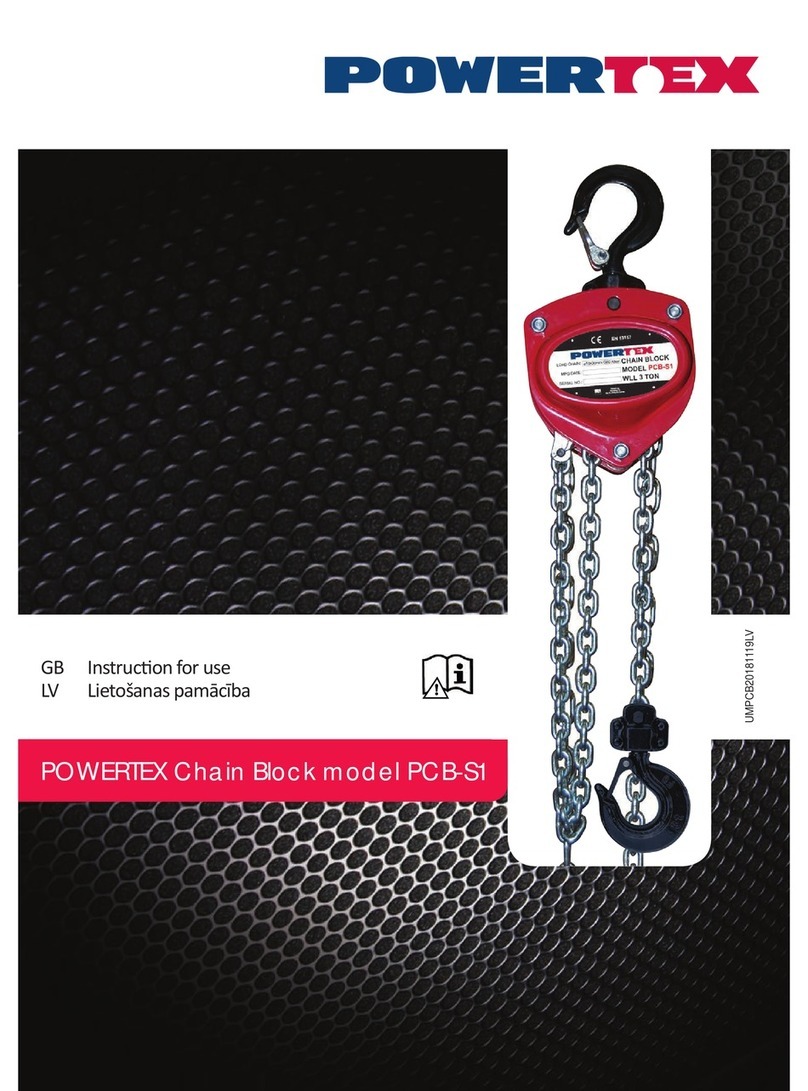
POWERTEX
POWERTEX PCB-S1 Instructions for use
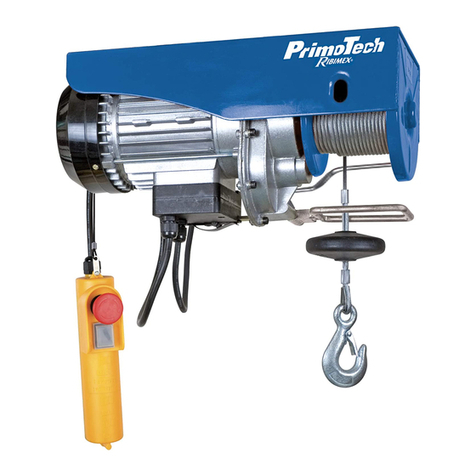
Ribimex
Ribimex Ribitech PE100/200PT User and maintenance manual
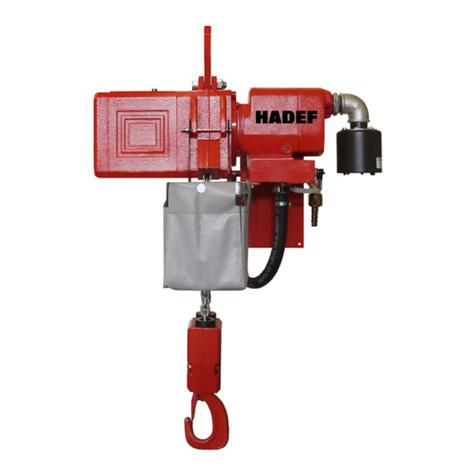
HADEF
HADEF 70/06 APS Installation, operating and maintenance instructions

Total
Total TLH1952 manual
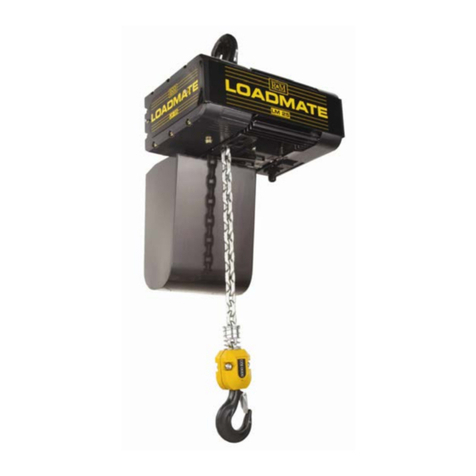
R&M
R&M LM Installation and maintenance manual
